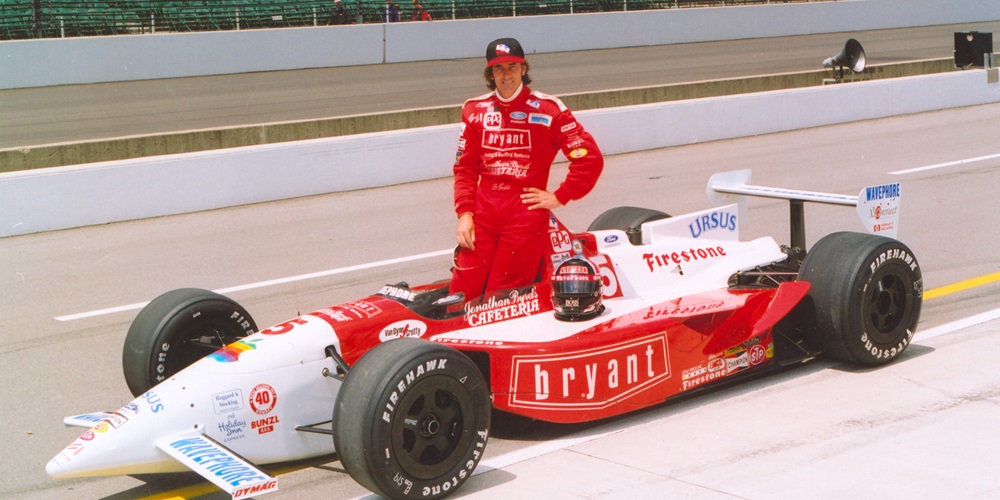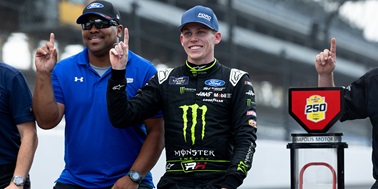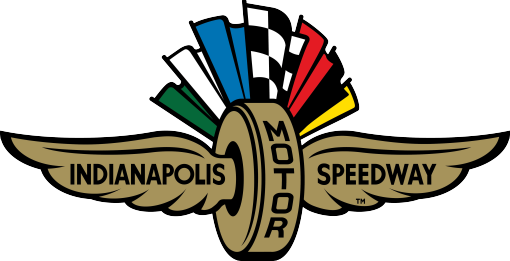Arie Luyendyk can still recall how his ears were popping every time his No. 5 Jonathan Byrd/Treadway Racing car sped out of the fourth turn at the Indianapolis Motor Speedway.
Nineteen years ago today, Luyendyk drove that red and white, Cosworth Ford-powered Reynard with Firestone tires into Indianapolis 500 qualifying history.
His four-lap qualifying average of 236.986 mph is a record that still stands today, as does his final-lap qualifying speed of 237.498 mph.
“The Flying Dutchman” from the Netherlands, now 61 and a Verizon IndyCar Series driver coach/race steward, remembers the experience well. Succinctly, he went real fast.
“Yeah, that’s about it,” he said Monday at IMS. “That sums it up.
“The car was just phenomenal. It couldn’t be any better around here. I’ve never had a car like it. The handling was just, I could do anything with it.”
Luyendyk first noticed the ear popping in practice, especially when he actually went faster, turning a lap of 239.260 mph on May 10 to set an unofficial track record that also still stands.
“My ears would pop coming out of Turn 4, every time, like you have in a plane,” he said. “Never before, never after. It was just the speed, I guess, and whatever was going on in my head (laughs).”
While Luyendyk zoomed faster than ever before, he didn’t actually win the pole. He initially qualified at 233.390 mph, but Scott Brayton’s late run dropped Luyendyk to second, then a post-qualifying inspection disqualified Luyendyk’s primary car for being seven pounds underweight.
Yes, the record run actually came in a backup car and a day later on Sunday. Because it was a second-day qualifying effort, making history translated to starting in 20th. But it sure was impressive. Each lap set “a new-w-w tra-a-a-ck record,” as announcer Tom Carnegie used to love to say ever so deliberately with his deep, booming voice.
Luyendyk went 236.239 mph in the first lap, then 236.948 mph, 237.260 mph and finally 237.498 mph.
He admits getting acclimated to the faster speeds took time, but that was expected for Indianapolis.
“Here’s the thing about Indy, you show up here and you haven’t been going that fast on any of the other tracks, so your body always needs to adjust to the speeds,” he said. “As we went along through the Month of May, my body adjusted to going 233, 235, 236, 237 and then we had that 239 with a tow. That was just like a marketing lap because I was hoping to get to 240, to put up that big number, but obviously it was a lap with a draft that I had off a car in front of me. It felt that fast. It was fast and it felt that fast.
“Of course you can feel the speed, but you’re so tuned into looking at your RPMs, what kind of RPMs do I have coming off 4 and coming off 2. We had the data to look at and I always used to looked at my RPMs. You knew that you were flat out, you were full throttle. By the way that you approached the corner, by the way that you turned the steering wheel, you can either increase or decrease your RPMs. I was always looking for that sweet spot, obviously. Yeah, you know you’re going that fast. I always said it’s just a number because in the end, it is just a number. You still have the feel of the car, you have the feel of what’s going on, it just happens a little bit quicker.”
Brayton died in a practice crash the following Friday. Growing safety concerns as well as the desire to have a more level playing field with less-expensive cars and production-based engines prompted the Indy Racing League to make changes which dropped speeds dramatically the next year.
“Well, we didn’t have soft walls back then. We didn’t have all the protection around our heads that we have now. We didn’t have the good seats,” Luyendyk said. “Scott Brayton crashed that year, he hit the wall at a bad angle and died. The impact was enormous when he hit the wall. Looking at that, then you say, yeah, it was too fast for the impact.”
Luyendyk knew he had a car capable of winning, but that didn’t happen.
“I got hit leaving the pits by (Eliseo) Salazar. It broke the car,” he said of finishing 16th after completing 149 laps. “I think I could have won that year.”
He had won the race before in 1990 for Doug Shierson Racing, then again for Treadway Racing in 1997, the year after he set all those records.
Luyendyk won seven times in his 71-race career and was inducted into the Motorsports Hall of Fame of America last year. He drove in 17 Indy 500s, the last in 2002. In addition to his victories, he was second in 1993 and third in 1991.
Did he expect his records to stand to this day?
“I thought it would last for a really long time based on the fact of where the IndyCar Series was going and what they came out with,” he said. “The following year, I sat on the pole with a 218, so we’re talking about 20 miles-per-hour difference. So I knew then it would be quite a while before they would get it again.”
Luyendyk actually would like to see his records broken.
“It’s always fun to set the record, but it’s not a must to keep it,” he said. “Records are there to be broken. It’s not like I want to keep this record forever.
“I would like to see hundreds of thousands of fans come out here and see somebody actually break the record with the anticipation of the record being broken, with the crowds here to watch it. That would be cool. I’m all for that.”
Luyendyk Remembers Track-Record Run, 19 Years Ago Today

Nineteen years ago today, Luyendyk drove that red and white, Cosworth Ford-powered Reynard with Firestone tires into Indianapolis 500 qualifying history.
Latest News
View All News
Five Significant Moments in Brickyard History
The roar of stock cars has been reverberating through Indianapolis Motor Speedway’s hallowed grandstands since the first NASCAR Cup Series race in 1994. The inaugural Brickyard 400 became the first race other than the Indianapolis 500 in nearly a century, setting the stage for additional motorsports events to be held at Indy.

Ron McQueeney, Longtime IMS Photographer, Dies at 80
Ron McQueeney, one of Indianapolis Motor Speedway’s best-known photographers and its longtime director of photography, passed away July 14 in Indianapolis. He was 80.

Riley Herbst Eager for First Cup Opportunity at IMS
Riley Herbst will be returning to Indianapolis Motor Speedway next week for NASCAR’s annual event, but this time he is stepping up to stock car racing’s biggest stage.
